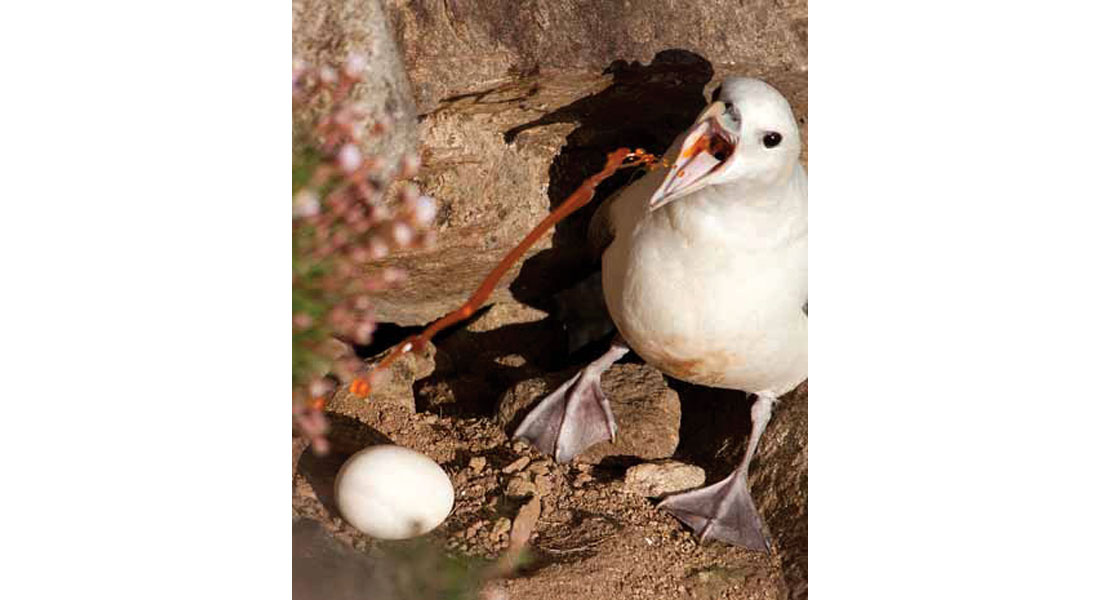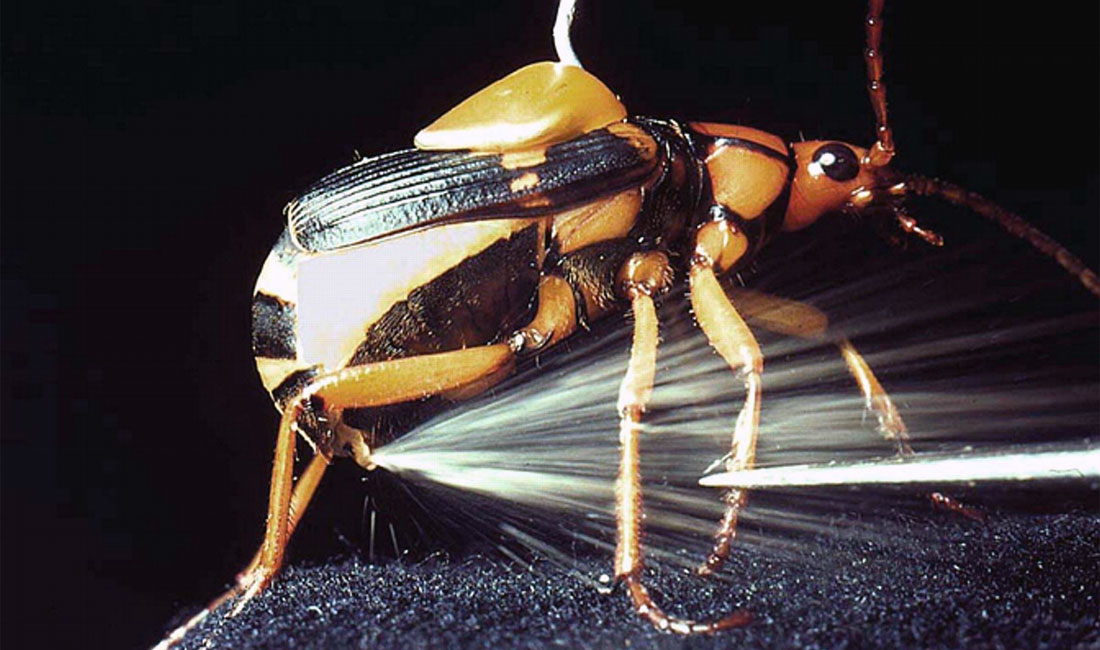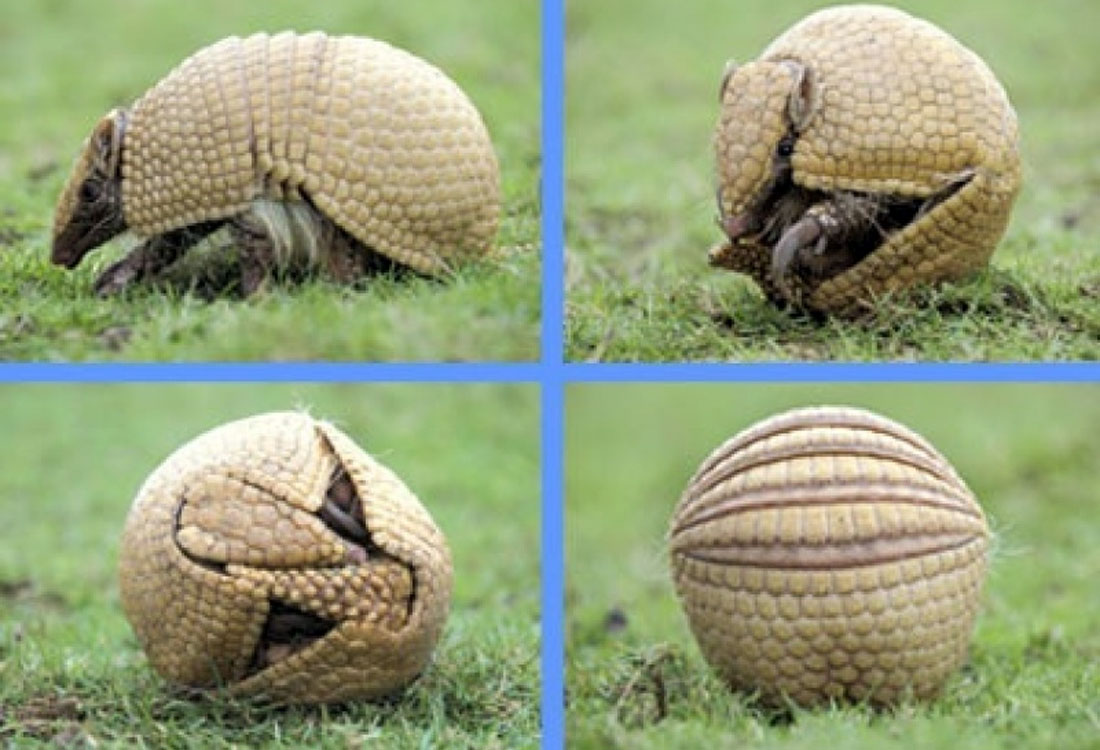One evening last summer our dog was in a frenzy – he’d cornered some critter under our deck, most likely a raccoon. However, the flashlight revealed a white, mangy little creature about the size of a cat. Its head, especially the jaw, was large in proportion to its body, and long canine teeth sticking out at an odd angle made it look like a small warthog, although more snouty. Instead of fighting back, it appeared to be passed out or dead; it was lying on its side, mouth open, and an unholy stench filled the air. Our dog appeared confused and just barked and lunged ineffectually at the inert body.
I identified it as a possum, or more correctly the Virginia opossum (Didelphis virginiana) (Figure 1). I saw it, alive and well, a couple more times over the following nights, and then it must have moved on. But the smell… when attacked, the opossum literally faints, taking on the appearance of death for several hours, and a foul smelling liquid is excreted by its anal glands. Apparently this is a highly effective defense mechanism, as most predators prefer or expect to kill and eat live prey.

The opossum is interesting in a few other respects. With warmer temperatures it has extended its range northward to just include Toronto. It is a marsupial, the only one living in Canada in the wild. The Didelphis refers to the female’s bifurcated vagina, which is complemented by the pronged penis of the male. It possesses one of nature’s most resilient immune systems, capable of metabolizing even the most venomous snake bites; snakes make up a good part of its diet in the heart of its natural territory, the southern US. The robust immune system enables it to eat just about anything, including severely rotten and infected meat, meaning it can encroach into new territories such as Toronto where large numbers of scavenging omnivores such as raccoons and skunks already exist.
The animal kingdom is full of bizarre and unusual defense mechanisms, as evolutionary forces drive a never ending arms race between hunter and hunted, in every niche of every ecosystem. This article takes a look at just a few. In conducting my research I realized just how much plagiarism exists on the Internet – a search on “unusual animal defenses” generates innumerable sites repeating the same list of 10 to 20 animals. How dare they pre-empt my own plagiaristic research methods??! So instead of trotting out the same list, I have categorized my list by general strategy
Thanatosis
This is the technical term given to the above mentioned playing dead strategy (Figure 2). It is more common than you may think, found in a broad array of mammals, reptiles, fish and insects. Some good examples include the Eastern hog-nosed snake, the brown widow spider, and quail, where thanatosis has definitively been shown to reduce predation by cats. The strategy appears to exploit two natural predator tendencies. First, as mentioned, many predators prefer to eat prey they have killed, probably an evolutionary adaption to avoid infections from diseased and bacteria infested meat. Second, a predator will let its guard down momentarily upon being duped into thinking the prey is dead – this can allow the prey an opportunity to escape or counter-attack.

Thanatosis is sometimes referred to as tonic immobility (TI). I believe two responses are being lumped together under one name. Thanatosis is definitely an adapted defensive strategy, but many animals can become so overcome by fear that they are rendered immobile and very vulnerable, including humans. Some fish, especially sharks, experience TI when flipped upside down. Orcas reportedly exploit this, including instances where they flip great white sharks and manta rays upside down, and then eat them in their resulting defenseless state. Interestingly, some species use thanatosis for other purposes: some cichlids con scavengers into thinking they are dead, and then “wake up” to kill and eat the presumptuous predator! Some male spiders after mating play dead to avoid being eaten by their hungry mates.
Vomiting
Frat boys and girls use this strategy to help keep the human gene pool healthy, by repelling potential mates. Many other animals use vomiting defensively, including the turkey vulture (Cathartes aura). Coincidentally, I also had a close encounter with turkey vultures last summer, but not close enough to experience their projectile vomiting. Hiking along the Bruce Trail, hidden within cedars clinging to the top of the escarpment, we happened upon a turkey vulture family sitting in a dead tree at eye level. When threatened, these birds can vomit the contents of their stomachs, mostly partially digested scavenged meat, onto their attackers. This startling effect buys them time to escape. Being lighter they can take off quicker, plus their vomit smells disgusting and is highly acidic, so it tends to burn skin and eyes and deters further attack.

Another species that uses vomit as a defense is the northern fulmar (Fulmaris glacialis), which is a subarctic sea bird (Figure 3). Fulmar chicks vomit putrid, bright orange stomach oil onto attackers. Besides the off-putting smell, the oil forms clumps in feathers lowering their water repellency, rendering the attackers somewhat unable to fly, swim and in some cases stay warm enough to survive. The smell also alerts the nearby parents to come to the rescue. Eurasian roller (Coracias garrulous) chicks do much the same thing – under attack they vomit and then roll in it, making themselves extremely unappetizing and in their case warning the parents to stay away. Various moths and caterpillars also regurgitate noxious fluids to repel attackers.
Chemicals
Chemicals are used widely for defensive purposes, and in a broad range of ways.
The armoured ground cricket (Acanthoplus discoidalis), when unable to bite with its formidable mandibles, such as when attacked from above or side, can auto-hemorrhage, shooting out streams of toxic blood through holes in its exoskeleton to a distance of about 3 cm, enough to fend off most attackers. The poisonous phytotoxins are derived from the crickets’ diet, and so after an attack response they clean themselves meticulously, to avoid being eaten by others of their own kind, a common occurrence.
Over their lifetimes, workers – not soldiers or breeders – within French Guiana termite (Neocapritermes taracua) colonies produce blue hemocyanin protein crystals from abdominal glands. Typically hemocyanin is found in animal blood as an alternative to hemoglobin – two copper atoms bind to a single O2 molecule – but in this case the crystals are stored in a sac close to the salivary glands, ready for defensive deployment. When the termite nest is attacked, bites from the attackers and/or other termites cause the sacs to rupture, and the hemocyanin crystals mix with saliva, spraying the attackers with a toxic liquid. Usually this happens in the termite tunnels, and the dead bodies of the attackers and suicide bombers quickly block further incursions by the enemy. Interestingly, the older workers, whose usefulness has otherwise ended due to worn mandibles and lower energy levels, are more expendable, and they possess the most crystals and produce the most toxic spray; these older workers are sacrificed for the greater good. Humans do it the other way around – perversely, in war we send our young healthy males off to get killed on our behalf.
This form of suicidal altruism is common among many social insect species. Another great example is the Malaysian carpenter ant Camponotus saundersi. These ants often get into fights with other ant colonies over food resources. They possess mandibular glands that run down each side of their bodies. In normal day-to-day conflicts the glands secrete a somewhat poisonous adhesive to their enormous mandibles, which makes them not only physically but also chemically dangerous. If a conflict escalates enough, the ant will squeeze its gaster (the bulbous abdominal segment found at the rear of many insects) to the point that it ruptures the mandibular glands at the intersegmal fold, and the corrosive contents spray out in all directions, sticking to the enemies, chemically irritating them and causing their various limbs to get gummed up. The substance is made up of polyacetates, aliphatic hydrocarbons, and alcohols – essentially a toxic glue.
Bombardier beetles (500+ species in the family Carabidae) are famous, partly because creationists hold them up as examples of irreducible complexity that refute the theory of evolution, but mainly because they possess amazing chemical missile launchers in their butts (Figure 4). Actually they have two identical systems, one on each side of the anus. There is a large inner chamber that collects a mix of 25% hydrogen peroxide and 10% hydroquinone; together these substances oxidise benignly as a brownish liquid. However, there is a smaller outer chamber, an extension of the anus with a thick chitin lining, which collects a ~50% albumin solution that is one third peroxidase and two thirds catalase. When the beetle wants to fire, it squeezes its abdominal muscles, which force a small amount of the hydrogen peroxide / hydroquinone mix through a one way valve into the outer chamber. The catalyst waiting there reacts immediately with the mix, and the resulting explosion sends a scalding 100°C quinone / oxygen / water jet out of the anus, fatal to most insect predators and very painful to birds and mammals. Some species even have 270° directional nozzles that allow pinpoint shooting accuracy.

Regarding the creationist arguments, they are based on a misunderstanding of the chemistry. The argument is that hydrogen peroxide and hydroquinone on their own combine explosively, and so there is no way evolution could gradually, incrementally produce a system that wouldn’t blow up its owner the very first time the two substances came together. Instead, creationists posit that divine intervention designed a system made up of hydrogen peroxide, hydroquinone, an inhibitor, and an anti-inhibitor. In fact, hydrogen peroxide and hydroquinone are not explosive without a catalyst, and it is possible to imagine a plausible sequence of evolutionary steps that could have produced the system (The infinite variety blog, 2010). Incidentally, creationists also use the bombardier beetle as an animal fire production proof of concept, supporting the idea that dragons mentioned in the Bible did exist; the bones most accept as those of dinosaurs were in fact from dragons, and the various head frills were parts of their fire breathing systems, similar to the beetles’ butts. Or so the theory goes.

Larval three-lined potato beetles (Figure 5) of the family Solanaceae prefer to eat alkaloids such as nightshade. Their feces are redirected through a special gland on their backs, to form a fecal shield that is poisonous to mammals. Fire ants actually want to eat that fecal shield, so they protect the beetle larvae to maturity, like little insect Laplanders.
There are over 1700 species of sea cucumber in the class Holothuroidea, and many of them use chemical defenses in very unusual ways: some can extrude, or self-eviscerate, internal organs through the anus, and these organs are often saturated with the toxin holothurin. This might seem suicidal, but the sea cucumbers are not adversely affected, and the organs regenerate within 2-6 weeks. With some sea cucumber species, included in the ejected organs are Cuvierian tubules, which are part of the cucumber’s respiratory tree. Upon ejection they fill with water, and expand to 20 times their original length. These tubes are extremely sticky and toxic, and quickly entangle predators such as crabs. The evisceration process is extremely interesting – a good summary of it can be found in the Wikipedia entry under “evisceration (autotomy)”.
Armour
Lots of animals fall into this category – it’s a very common form of defense: turtles, snails, etc. I just wanted to feature two of my favourite animals, the pangolin (order Pholidota) and armadillo (two families under the order Cingulata). I saw the former a few times as a child in East Africa. When attacked they curl up into almost perfect armoured balls. The exterior that is exposed in this defensive pose is covered in tough keratin scales, unique among mammals. Pangolins primarily eat ants and termites; they have long claws evolved for digging into ant and termite mounds, and long sticky tongues to insert into the nests. In fact, the tongues extend well into their stomachs and are as long as their bodies, up to 1 m! Unfortunately they are widely trafficked, driven by the usual culprits, East Asians who believe the ground up scales have medicinal properties (they do not), and a general appetite for their meat, which is apparently quite tasty.

Armadillos are similar, also rolling up into armoured balls to defend themselves (Figure 6). Their armour is a combination of larger plates of dermal bone and scutes. Scutes are a type of epidermal scale, with a keratin coating over underlying bone platelets. I once thought the exceedingly rare Javan rhino (Rhinoceros sondaicus) was armour-plated, but it is in appearance only. Its thick skin is arranged in a specific pattern with overlap folds that creates the look of plates.
James Bond Stuff
By this I mean the discharge of substances in ingenious ways to hinder and otherwise confuse attackers (like Aston Martins that give off smoke, slippery oil, etc.) The rare toothed pygmy sperm whale (Kogia breviceps), about the size of a dolphin, when attacked will eject a bright red odorless anal syrup that acts as a smokescreen of sorts, facilitating escape. To make sure the syrup spreads into a large cloud, the whale agitates its tail flukes. Many squid and octopus of course use an ink in a similar fashion. BTW, octopus comes from a Greek root word, so when people use the plural 'octopi', not only are they pretentious, they are also grammatically incorrect.
The hagfish (class Myxini), under attack, exudes a highly concentrated form of saliva which quickly turns into a surprisingly large volume (~20 l) of gelatinous slime, which tastes bad and also gums up the attackers’ gills, essentially suffocating them. The saliva is produced by about 100 glands found along the length of the fish, and it contains 15 cm-long curled-up protein threads that unwind upon exposure to salt water.
Camouflage
There are thousands, perhaps millions of species that use camouflage for defensive purposes. The Japetella heathi octopus (Figure 7) is unique though. Predators at the dark 600 m plus depths that it lives in usually hunt for prey by spotting their dim silhouettes from below, and so these octopuses (the humble plural) by default are transparent with their only “solid” parts – eyes and guts – being reflective, rendering them invisible from below. However, if they detect bioluminescence from a fish that employs such a source of light for hunting purposes (like the anglerfish, order Lophiiformes), then their bodies immediately change to a deep red colour, essentially invisible to “headlight” predators.

Weaponry
The Hairy frog (Trichobatrachus robustus) reminds me of Marvel Comics’ Wolverine, and in fact it is sometimes referred to as the Wolverine frog. In more dramatic descriptions the frog is said to break its fingers/ toes, then push the jagged ends of broken bones through its skin to create sharp weapons with which to fend off its attackers. In fact, there is a bone nodule attached by collagen at the end of each toe. When sufficiently threatened, the frog breaks the attachment, and the sharp toe ends are pushed through the skin to form a claw. If it survives the attack the bones are retracted, the skin heals and the nodules and attachments regenerate.
Similarly, the Iberian (or Spanish) ribbed newt (Pleurodeles waltl) possesses sharp rib bones that normally lie under the skin. When attacked, the newt pushes these rib bones through tubercules running along the sides of its body. Simultaneously glands around the tubercules secrete a poison. The bony spikes pierce a predator’s skin – especially the softer skin inside the mouth of anything trying to eat the newt – allowing the poison to enter the predator’s body, which causes it to release the newt relatively unharmed. The spikes retract and the skin quickly heals over. An interesting note is that Iberian newts have been sent into space several times. They are very useful in experiments, most notably because the female can carry live sperm in her cloaca for up to 5 months, meaning researchers can stimulate production of offspring in outer space via timed hormone treatment and thus study the effects of zero gravity and the like at various stages of fetal development.
The potto (Perodicticus potto) also possesses bony spikes under tubercules, but they are located on its neck vertebrae. When attacked it lowers it heads and does a sort of neck butt maneuver to defend itself. Also, its saliva possesses inflammatory compounds. Generally it is a slow moving herbivore, living high in the tree canopies of tropical West Africa, and avoids attacks by keeping a low profile at great heights.
Boxer crabs (family Xanthidae) (Figure 8) defending themselves are one of the cutest things you’ll ever see. They hold poisonous sea anemones in their claws, and when attacked, wave them around in a threatening way, like feisty featherweights. In return the anemones get carried around and exposed to more food, mostly scraps that don’t quite make it into the crabs’ mouths. The crabs also use the anemones to paralyze small prey, which they then eat.

There are numerous other defensive tactics that I could include, but space doesn’t allow. These include sacrificial limbs, mimicry, dilution etc. The Wikipedia entry on anti-predator adaption given below is a great place to start if you’re interested.











Share This Column